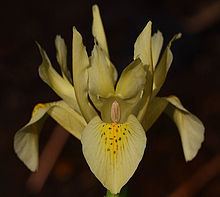Subfamily Iridoideae Subgenus Hermodactyloides Genus Irises | Tribe Irideae Section Reticulatae Rank Species | |
 | ||
Similar | ||
Iris winogradowii is a species in the genus Iris, also in the subgenus of Hermodactyloides and section Reticulatae. It is a bulbous perennial, from the Caucasus mountains of Azerbaijan and Georgia.
Contents
Description
It has pale primose yellow flowers, with green spots on the falls, the scented flowers are up 5 cm tall and emerge between April and May. With stem and flower the plant reaches a height of 10–15 cm. The leaves emerge after flowering and grow up to 30–40 cm. It has between 2-4 leaves each growing season.
Taxonomy
It is sometimes known from the common name of Wingradoff's iris.
It was named after P.Z. Winogradow-Nitikin who first described it.
It was first found in 1914 and then published and described by Aleksandr Vasiljevich Fomin in 'Schedule Herb Flora Caucasus'. Vol.4 on page 88 in 1914.
An illustration was seen in 1961 in the 'Collins Guide to Bulbs'. It was grown in Australia from seed provided by the Komarov Botanical Institute in St. Petersburg in 1972.
It was verified by United States Department of Agriculture and the Agricultural Research Service on 4 April 2003, then updated on 1 December 2004.
Iris winogradowii is an accepted name by the RHS. The iris later gained the RHS's Award of Garden Merit.
Distribution and habitat
It is native to temperate Asia.
Range
It is found in Azerbaijan and Georgia.
In 1972, Dr Rodionenko noted that several hundred iris plants were on Mount Lomtismta near Bakuriani, (in Georgia)..
Habitat
In 1914, it was originally found in the gravelly soils of the alpine meadows of Mount Lomtismta. Part of the Caucasus regions of Adzharo-Imeretinskiy Range.
Conservation
The plant is now on the endangered list. Now only found in the republics of Georgia and Abkhazia. Only a couple of hundred plants existed in 1978.
Cultivation
It was first grown in the UK in 1923.
Due to its alpine origins, it prefers to grow in semi-shade in cool peat enriched soils.
It is normally grown in a rock garden, alpine house or bulb frame. In gardens it prefers humus-rich, porous soil in cool shade and does best if replanted each year after a fairly dry summer.
It has been remarked that this species is difficult to grow in a pot.
Cultivars
In 1960, E.B. Anderson created the hybrid of Iris histrioides and Iris winogradowii. He then named the plant after the wife of a fellow enthusiast, Eliot Hodgkin (mother of Sir Gordon Howard Eliot Hodgkin). Iris Katharine Hodgkin has light blue standards and pale yellow falls.
Iris 'Sheila Ann Germaney' is another hybrid between Iris histrioides and Iris winogradowii. It is similar to 'Katherine Hodgkin', with a paler blue tone and less yellow colouring.
Iris 'Frank Elder' is a white form hybrid.
